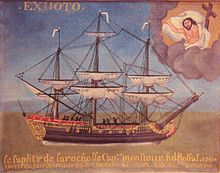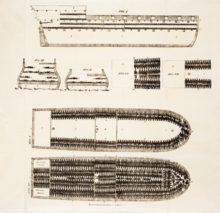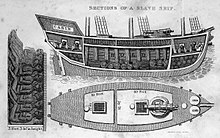List of slave ships


Diagram of a four-deck large slave ship. Thomas Clarkson: The cries of Africa to the inhabitants of Europe, 1822?

The slave-ship Veloz, illustrated in 1830. It held over 550 slaves.[1]
This is a list of slave ships. These were ships used to carry enslaved people, mainly in the Atlantic slave trade between the 16th and the 19th centuries.
- Antelope, Spanish slave ship captured near Florida in 1820 with 283 slaves aboard, leading to The Antelope case.
- Aurore, along with Duc du Maine, the first French slave ships that brought the first slaves to Louisiana.
- La Amistad, general-purpose cargo ship that also carried slaves on occasion. A successful slave revolt on ship gave rise to a case that reached the Supreme Court in United States v. The Amistad.
- Beeckestijn, Dutch West India Company slaver 1722-1736.
- Brookes, sailing in the 1780s.[2]
- City of Norfolk, fitted out in New York City by Albert Horn.[3]
- Clotilda, burned and sunk at Mobile, in 1859 or 1860.
- Cora, captured by USS Constellation in 1860.
- Creole, involved in the United States coastwise slave trade and the scene of a slave rebellion in 1841, leading to the Creole case.
- Desire, first American slave ship.[4]
- Duc du Maine, along with Aurore, the first French slave ships that brought the first slaves to Louisiana.
- Elisabeth, sailing from Jamaica for West Africa.[citation needed]
- Erie, the ship owned and captained by Nathaniel Gordon, the only American executed for slave trading
- Esmeralda, captured 1 November 1864 off Loango, West Coast of Africa, by HMS Rattler (1864) and Taken to St. Helena to prize court by C.G. Nelson midshipman in command.[citation needed]
- Fredensborg, Danish slave ship, sank in 1768 off Tromøya in Norway, after a journey in the triangular trade. wrote a book about the journey.
- Gallito, Spanish slave ship carrying 136 Africans when captured by HMS Nimble 16 November 1829.
- Guerrero, Spanish slave ship wrecked in the Florida Keys in 1827 carrying 561 Africans.
- Hannibal, an English slaver of the Atlantic slave trade.
- The Hawk, The Hawk sailed for Calabar, with instructions to buy 340 slaves.[5]
- Hebe, Portuguese slave ship carrying 401 Angolans when captured by HMS Nimble 13 July 1832.
- Henrietta Marie, sank in 1700 near Marquesas Keys, Florida, excavated in 1980s.
- Hermosa, a schooner whose 1840 grounding in the Bahamas led to a controversy between the US and Britain over the 38 slaves who had been on board the ship.
- Hope, American brig that brought slaves to Rhode Island
- Isabella, British slave ship that brought the first 150 African slaves to the American port of Philadelphia in 1684.
- Joaquina, Spanish slave ship carrying 348 Africans when captured by HMS Nimble 10 November 1833.
- Josefa, Spanish schooner carrying 206 slaves when captured by HMS Monkey 7 April 1829.
- Jesus of Lübeck, a 700-ton ship used on the second voyage of John Hawkins to transport 400 captured Africans in 1564. Queen Elizabeth I was his partner and rented him the vessel.
- King David, sailing from St Christophers, on St Kitts in the Caribbean 1749.[6]
- La Concord, a slave ship captured by the pirate Blackbeard (Edward Teach), used as his flagship and renamed Queen Anne's Revenge. Run aground in June 1718.
- La Negrita, Spanish slave ship carrying 189 Africans when captured by HMS Nimble May 1833.
- Leusden, Dutch West Indies Company slave ship wrecked in 1738 at the mouth of the Maroni river in Surinam where the crew killed nearly 700 African slaves.
- Lord Ligonier. See Roots: The Saga of an American Family by Alex Haley.
- Don Francisco, a slave ship captured in 1837. Sold as a colonial trader and renamed . Excavated by Western Australian Museum in 1974.
- Madre de Deus, 1567. John Hawkins captured this ship and transported 400 Africans.
- Manuela, built as clipper ship Sunny South, captured by HMS Brisk in Mozambique Channel with over 800 slaves aboard.
- Marie Séraphique, French vessel sailing from Nantes
- Manuelita, Spanish slave ship carrying 485 Africans when captured by HMS Nimble 7 December 1833.
- Margaret Scott, confiscated and sunk as part of the Stone fleet in 1862
- Meermin, a Dutch East India Company ship active between southern Africa and Madagascar, whose final voyage in 1766 ended in mutiny by the slaves: around half the crew and nearly 30 Malagasy died, and the ship was destroyed.[7]
- Midas, 360-ton Spanish slave ship captured by HMS Monkey 27 June 1829. Midas had left Africa in April 1829 with 562 Africans, but only 369 were still alive when she was captured, and 72 more died of "smallpox, diarrhea & scurvy" before Monkey and HMS Nimble could take Midas into Havana.[8]
- Nightingale, clipper ship captured by Saratoga near Cabinda, Angola in 1861 with 961 slaves aboard.
- , American-built barque captured by USS Yorktown on 1 December 1845 with 850–900 slaves.[9]
- Providencia, Spanish brig carrying 400 slaves when captured by HMS Monkey in 1829.
- São José Paquete Africa, a Portuguese slave ship which sank off the coast of South Africa in 1794 killing over 200 of the enslaved men and women.
- Tecora, Portuguese slave ship that transported the slaves who would later revolt aboard La Amistad.
- Triton captured by USS Constellation in 1861.[citation needed]
- Trouvadore, wrecked in Turks and Caicos 1841. 193 slaves survived. Project commenced in 2004 to locate the ship.[10]
- Wanderer, formerly last slave ship to the U.S. (November 1858) until Clotilda reported in 1859 or 1860.
- Wildfire, a barque, arrested off the Florida coast by the US Navy in 1860; carrying 450 slaves.[11]
- Whydah Gally, a ship that transported cargo, passengers, and slaves. Captured by the pirate Captain Samuel "Black Sam" Bellamy and used for piracy, eventually grounded during a Nor'easter at Cape Cod and sunk in April 1717.
- Zong, a British slave ship infamous for the 1781 massacre of 132 sick and dying slaves who were thrown overboard in an attempt to guarantee that the ship's owners could collect on their cargo insurance.
References[]
- ^ Walsh, R. (Robert) (10 August 1830). "Notices of Brazil in 1828 and 1829". London, F. Westley and A. H. Davis. Retrieved 10 August 2019 – via Internet Archive.
- ^ "Brooks Slave Ship". E. Chambre Hardman Archives. Archived from the original on 13 October 2007. Retrieved 28 February 2008.
- ^ Why the Tombs for Slave Trade Execution. Correctionhistory.org (30 November 1907). Retrieved on 2015-12-03.
- ^ "Encyclopedia". Retrieved 3 July 2011.
- ^ "Bristol Slavery Muster Rolls for The Hawk". Retrieved 26 Dec 2018.
- ^ "Bristol Slavery Muster Rolls for The King David". Retrieved 26 Dec 2018.
- ^ "The Slave Mutiny on the slaver ship Meermin". Cape Slavery Heritage. 26 March 2008. Retrieved 14 October 2011.
- ^ Swanson, Gail (2005). Slave Ship Guerrero. West Conshohocken, Pennsylvania: Infinity Publishing. pp. 10–11, 130–31. ISBN 0-7414-2765-6.
- ^ Gilliland, C. Herbert (2003). "Deliverance from this Floating Hell". Naval History. 17 (48–51): 20–27.
- ^ "Slave Ship Trouvadore Website". Turks & Caicos National Museum and Ships of Discovery. Retrieved 1 October 2012.
- ^ Harper's Weekly, 2 June 1860, p344. Online at The Slave Heritage Resource Center accessed 3 July 2006.
Categories:
- Lists of sailing ships
- Lists of ships
- Slave ships